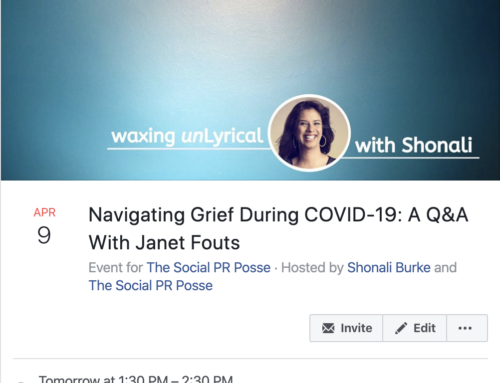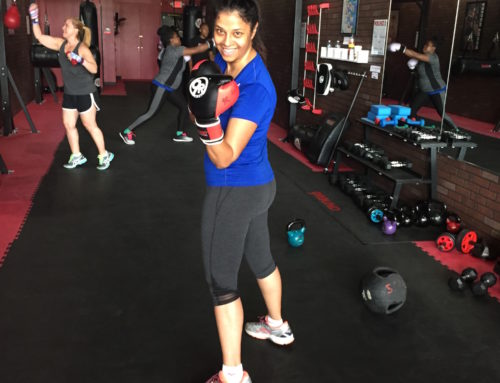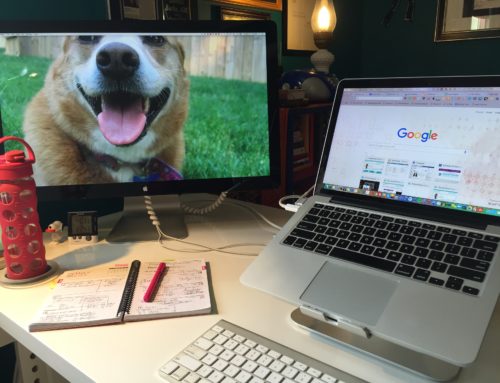 I don’t know what it is with us PR folk, but we like to use words, phrases, analogies that evoke destruction when we put our rah-rah hats on.
I don’t know what it is with us PR folk, but we like to use words, phrases, analogies that evoke destruction when we put our rah-rah hats on.
“Sizzlin’!”
Image: heal and inspire via Flickr, Creative Commons
“Crush it!”
“Kill it!”
Whatever. We’re a bloodthirsty lot and happy to be so.
This past Sunday, I shared seven posts that I think make for great reading when you’re preparing for a presentation.
Today, I wanted to share seven lessons I learned as I prepared for Ignite DC No. 5, an experience I will never forget (thank you, Geoff Livingston, for making me do this).
And these are outside of the commonsense “know your audience,” etc.
They are also a testimonial to Jill Foster, who served as my unofficial coach for Ignite, because she really underscored the importance of what I’m about to tell you.
1. What is your story?
I am envious of speakers who have the perfect anecdote or joke ready to warm their audience up… because I usually don’t. They begin with a short story that they come back to at some point in the presentation, that bears out the point they’re trying to make.
Even if you don’t have a funny story
I learned it’s important to set the stage for your story, and to tell the audience what they can expect over the course of the presentation.
This doesn’t mean you have to go into every detail. But you can take 15 seconds (that’s how much time each Ignite slide was allotted) to go through the top three or four “signposts” on the journey they are about to take with you.
So write – yes, write – out your story arc. Where will it begin, where will it go, and where will it end?
Then start filling it in.
2. Time yourself.
One of the most important things here is to time yourself.
The Ignite format is more tightly timed than others (5 minutes, 20 slides, 15 seconds per slide).
Most conferences allow somewhere in the region of 40 – 50 minutes for your entire presentation. That includes Q&A, which is often the most interesting part of the session.
That means your presentation itself should be no longer than 20-25 minutes. The only way you’ll know if you’re hitting the mark when it comes to timing is to time yourself.
There are a couple of ways to do this.
 First, and most basic, use a stopwatch to time yourself from start to finish. That way, you’ll get a sense of how long you’ll be carrying on.
First, and most basic, use a stopwatch to time yourself from start to finish. That way, you’ll get a sense of how long you’ll be carrying on.
Image: William Warby via Flickr, Creative Commons
Second, and I think a better way to do it, is to use the “custom slideshow” option in PowerPoint (which is still the most frequently used presentation tool), to set a specific time for each slide.
On a Mac (which is what I use), you go into “Slide Sorter” view, and then set the time for each slide (assuming they are the same) in “Transition Options.”
On a PC… you’re on your own, sorry!
Then practice to your timed slides. You’ll know where you’re going long, and where you need to add more content or repartee.
Once you’re comfortable with your story and its timing, I suggest removing the timing from the slides, because you have no way of knowing if/when the audience will interrupt you.
If they do, then it’s disconcerting to have your PPT proceed on its own without your accompanying commentary.
3. Identify the core message of your presentation.
While this might be one message, it could take the shape of two or three phrases that are central to your story arc.
For example, in my Ignite presentation, these were “humanity,” “the future,” and “ball of light.”
(You’re wondering just what the hey I was talking about now, aren’t you?)
This helps because
First, it will help you identify the most important moments in your story arc, which might help you with #1 above.
Second, if you find you have a few seconds to spare, you can fall back on these as gap-fillers.
 4. Practice your presentation standing up.
4. Practice your presentation standing up.
Once you’ve been through these steps, it’s time for you to do your presentation standing up, not sitting at your desk.
When you’re in the spotlight, your entire presentation mode will change.
Image: Chris Goldberg via Flickr, Creative Commons
Your energy, the inflections in your voice, how you use your hands… all these will come into play only if you simulate the environment you will actually be presenting in.
And that’s rarely sitting down.
For Ignite, I knew (thanks, again, to Jill) that I would likely not have a lavalier mic, but have to use a hand-held.
So I found a water bottle, and used it as my “pretend” mic as I practiced.
It made me pay attention to my posture, my hands, and everything else.
5. Make eye contact.
There is nothing more off-putting than a presenter who doesn’t look at her audience.
So practice looking at them… even if that means you’re making do with the couch or your dogs.
With an Ignite-style format, I knew that my slides would be projected on a screen in front of me.
The way I simulated this was to set up my timed presentation, stand a distance away from it, and ensure I was watching it out of the corner of my eye (to see when the slides advanced).
And then I talked to my couch.
Bet he has a story to tell.
6. Do not read your notes.
I know notes are really, really important and, if you’re taking your presentation really seriously, you’ll even have a script.
But what makes a good presentation is not making eye contact with three pieces of paper in front of you.
It’s knowing your stuff well enough to feel comfortable enough to look away from them (if you even have to hold them in your hand, which I would not recommend).
It’s looking at – and connecting with – your audience, so that you can pick up on their mood and ensure you are giving them what they thought they were getting.
You won’t be able to do that if you’re reading your presentation.
 7. Prepare, prepare, prepare… and then prepare some more.
7. Prepare, prepare, prepare… and then prepare some more.
Shaun Dakin, who gave one of the most engaging presentations (IMHO) of the Ignite evening, put this best in his recent recap post on preparing for the event.
Image: Luigi Anzivino via Flickr, Creative Commons
What Jill and I did was to set up daily sessions via Skype, since we couldn’t meet in person.
I would go through the presentation, and she’d give me notes.
We’d sign off, I’d have my homework, and then we’d do it all over again the next day… down to a few hours before the event, when she’d hit me with questions as to “what would you do if…” via text message.
I don’t think I’ve prepared as much for any presentation in recent memory. This is not because I don’t care about my audience; I do.
But it was a presentation completely out of my comfort zone.
So I prepared, prepared, prepared… and then prepared some more.
Those are the immediate tips I have for you
to set your presentations on fire… because if you do all this and have fun, real fun with your presentation, you’ll be able to have fun when you’re doing it.
And that’s the most important thing for you to CRUSH IT!
For what it’s worth, here’s my Ignite presentation. Once I went through all these steps, I had a ton of fun.
What would you add?






[…] Now, I haven’t had that many speaking coaches (after all, I went to drama school, so I’ve had lots of training in hamming it up), but I was able to experience Jill’s coaching and style firsthand when I was preparing for Ignite DC last year. […]
[…] Even if one has tried really really hard to set one’s presentation on fire? […]
[…] storytelling focus of Shonali […]
[…] Now, I haven’t had that many speaking coaches (after all, I went to drama school, so I’ve had lots of training in hamming it up), but I was able to experience Jill’s coaching and style firsthand when I was preparing for Ignite DC last year. […]
[…] in the Princeton area, I strongly recommend you hoof it over. I can’t even begin to tell you what a dynamite coach she is (well, I could begin, but I wouldn’t […]
[…] recent post, Seven Ways to Set Your Presentations on Fire, accomplishes this […]
Hello!
Just quickly I’d like to add that I find practising presentations in front of a lay man or women [non-experts] (often family/friend/partner) very useful. It doesn’t always help with the real technical stuff but it certainly helps me out where I could potential be confusing/boring/too fast or slow :)
Thanks for the tips!
Alex
That’s a really great tip, Alex. Once I was confident of my timing for Ignite, I practiced in front of my husband, and when he told me he enjoyed it, I felt much better.
Shonali -The Ignite talk was so good, resonant, playful, authentic! Thanks for the chance to be involved with your creativity.
To add to the great points shared here, one thing in particular comes to mind: being aware that storytelling involves conversational awareness – vs – 100% inclusion of details can really strengthen engagement. Often speakers are so interested in being completely forthcoming with detail that the natural story progression gets lost. Storytelling and the human voice that tells it are moving parts to an audience. So the audience’s brain in that dynamic absorbs info differently; and personality, cohesion, brevity, and succinct visuals really help deliver the story’s meaning.
Whew, thx for patience with the long wind; your Ignite talk was so fun and compelling.
That’s a really great point, Jill. Thank you again for your amazing coaching!
Nice tips! One I would add is to stop preparing 15 minutes or so before you head to your presentation. Spending that time just chilling out a bit (or giving yourself a little “you’ll do great” pep talk) helps keep the nerves at bay. Works for me!
That’s a good point, Kell. I’d take that a step further and say stop preparing a few hours before… but then get into the “zone” 15-30 minutes before.
This is to clear your head of clutter, so that you can actually focus on your presentation and what you hope the folks watching/listening will get out of it.
I think something a lot of people under-estimate is the power of being comfortable in what you’re wearing – you can’t be in front of people fussing with your blazer or dying because your new shoes give you blisters.
Very good point, Iris!
[…] This post was mentioned on Twitter by Shaun Dakin, Shonali Burke and Shane Jacob, PCDC Network. PCDC Network said: RT @shonali: New post: 7 Ways To Set Your Presentations On Fire http://t.co/8fDodOX h/t (my lessons learned from #ignitedc) ^sd […]